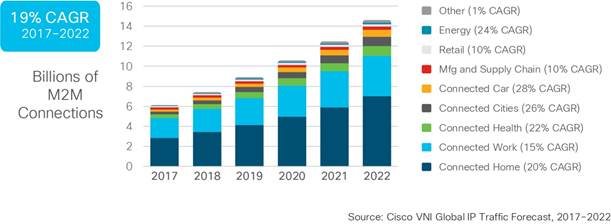The internet of things is hitting its stride and will shift from mere connections to “tangible value and monetization,” according to Cisco’s newly released Visual Networking Index forecast through 2022.
While Cisco expects the internet to reach 4.8 billion human users by the end of its forecast period — up from 3.4 billion last year — “what’s growing even faster than users are the devices and connections,” said Thomas Barnett, director of service provider marketing and thought leadership at Cisco.
By 2022, Cisco anticipates that 51% of global internet connections will be IoT connections such as sensors, video cameras and other “things”, with key growth areas coming in connected cars, smart cities and smart homes, Barnett said. High bandwidth IoT applications such as intelligent vehicles and video cameras will increase the overall percentage of internet traffic generated by IoT; in previous reports, Cisco noted, the percentage was “practically negligible”: less than 5% of all traffic. Now, Cisco expects that IoT connections will account for about 6% of total IP traffic by 2022.
In particular, according to Shruti Jain, senior analyst at Cisco, the addition of video cameras to various devices and connections — including machine-to-machine connections — is helping drive IoT-based video traffic. That includes applications such as public video surveillance, in-home surveillance and home security, she said.
“There is big growth happening in the video capabilities here,” Jain added.
Cisco said that IoT “is no longer a phenomenon, but it has become a prevalent system in which people, processes, data, and things connect to the internet and each other.” M2M connections will grow from 6.1 billion in 2017 to 14.6 billion by 2022, the company estimated. Connected home applications are anticipated to account for about 48% of the total M2M connections, while the connected car will be the fastest-growing IoT segment.

Image: Cisco VNI
Other highlights from the Cisco VNI forecast report included: –
– There will be an estimated 28.5 billion networked connections by the year 2022, and 82% of all IP traffic will be video.
-The average mobile network connection speed as of 2017 was 8.7 Mbps, according to Cisco, which will more than triple by 2022 to reach 28.5 Mbps.
-Wi-Fi speeds (from dual-mode mobile devices) will see a major jump, more than doubling by 2022. Cisco said that the average Wi-Fi connection speed was 24.4 Mbps in 2017, but will be more than 54.2 Mbps by 2022 — but North America will see even higher speeds: 83.8 Mbps. The number of global Wi-Fi hot spots will also increase from about 124 million in 2017 to 549 million in 2022.
-Mobile and Wi-Fi networks will carry the bulk of IP traffic. Cisco said that as of 2017, wireline network accounted for 48% of IP traffic, Wi-Fi carried 43% and cellular networks carried 9%. By 2022, Wi-Fi and mobile networks will carry 71% of IP traffic and wired networks will account for 48%.
-Cisco also noted that there is a major shift in network architecture underway, influenced by factors including more edge computing, the emergence of 5G (which it expects will carry 12% of global mobile traffic by 2022), the dominance of smartphones as access devices and the impact of IoT.
Read the full Cisco VNI Forecast here.
The post Cisco VNI: IoT moves from connections to value appeared first on RCR Wireless News.
